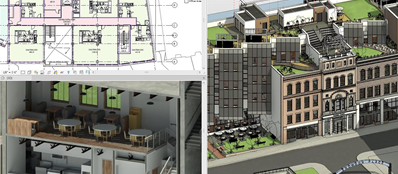How DT is used in Architecture


Design and Technology (DT) is a very important subject that helps to develop various skills, including technical knowledge, creative thinking and practical skills. These skills are crucial for solving real-world problems and advancing into STEM-based careers, due to their dexterity. This depth of DT scientific knowledge is transferable to various professions, including engineering and architecture. Major industries, such as architecture, are heavily reliant on DT, due to the various types of CAD and CAM software, which architects and engineers use and depend on daily. Furthermore, architecture is an AI-proof career, due to the complex creative thinking and problem-solving involved, making it highly unlikely to be replaced by artificial intelligence (AI). Therefore, the various types of CAD software taught in DT are very important when pursuing a career in STEM fields, especially architecture.
Firstly, computer-aided design (CAD) software, such as SketchUp and Revit, are used majorly by architects to help them quickly make and modify their architectural designs. There are numerous benefits of CAD, which include rapid prototyping/designing, quick revisions, and increased visualisation. Moreover, CAD has the ability to be integrated with other software, such as BIM (Building Information Modelling), which withholds data, such as a project’s overall cost; the functionality of the materials involved; the structural performance and safety of a building; as well as the sustainability of the whole architectural development (e.g. carbon emissions, energy-efficiency).
Secondly, rendering software, such as Enscape and Lumion, is frequently used by architects, in order to help enhance the realism of their architectural designs, by modifying shadows, ray-tracing and lighting. These effects improve the visualisation of the design for both the architect, stakeholders and client. Furthermore, virtual reality (VR) and augmented reality (AR) can also be linked to the rendering software, which gives architects the ability to showcase their designs to clients, stakeholders and other companies in an immersive manner.
Another way that DT is used in architecture is through the use of computer-aided manufacturing (CAM), which is used to prototype 3D physical models of houses, buildings and structural components within a short space of time. This allows architects to spot problems quickly and act on them swiftly, due to the increased visualisation of 3D physical models, in contrast to virtual architectural designs.
 In conclusion, DT is widely used in the architectural industry, from designing houses and buildings with CAD, to applying technical DT principles to architectural problems, to rapidly creating 3D prototypes of architectural designs and parts with CAM. DT is seen everywhere in architecture, and in numerous other STEM professions as well.
In conclusion, DT is widely used in the architectural industry, from designing houses and buildings with CAD, to applying technical DT principles to architectural problems, to rapidly creating 3D prototypes of architectural designs and parts with CAM. DT is seen everywhere in architecture, and in numerous other STEM professions as well.
Raiyan Singh Sangha, Year 12

